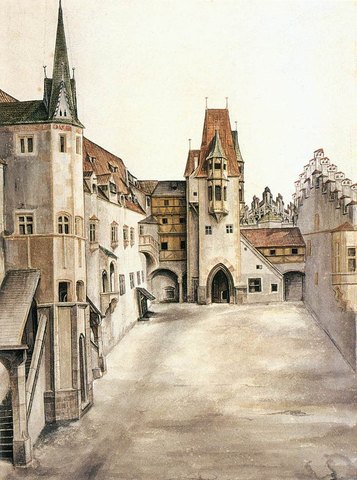F. In the middle of Europe

Fig. The Ducal court of Innsbruck. Albrecht Dürer, A castle yard. Watercolour (c. 1490), © Albertina Wien. This probably represents the ducal ‚middle court‘ (Mitterhof), with a small castle chapel in the gate-tower. Music of many countries was then being collected in Innsbruck: K. The Codex of Magister Nicolaus Leopold.
The music in the Austrian regions - because of their central location - was shaped by the interaction with other areas and dominions in Europe at that time. The great church councils of Constance (1414–1418) and Basel (1431–1449) and their musical activities were closely followed in Austria. On the basis of these influences, extensive sources of polyphonic music were created which reveal an as yet unexplored breadth in musical practices and production. From mid-century onwards, the music notated in the Trent Codices (located between north and south) represents musical artistry from almost all of Europe. Foreign musicians were increasingly employed at the Habsburg courts and at ecclesiastical centres. They enriched the indigenous traditions, so that local and foreign can often no longer be distinguished today. Repertorial interconnections with music from neighbouring countries such as Bohemia, Moravia and Italy can also be discerned in the music sources themselves. Church singing received local impulses through the veneration of local and “national” saints. Liturgical chant in Slovenia, then part of the Duchy of Carniola, was shaped by belonging to the Patriarchate of Aquileia. Special cultural relationships existed with Mediterranean countries with which there had been an exchange of music and musicians since the 14th century.
The essays marked with * are not yet available online.
Geistliche Mehrstimmigkeit in den jüngeren Trienter Codices*
Bob Mitchell, Reinhard StrohmMusiker aus anderen Ländern; Eigenes und Fremdes*
Reinhard StrohmSources of Polyphony in the Bohemian lands c. 1470–c. 1500
Lenka HlávkováMusik und Verehrung von (Lokal-)Heiligen
David MerlinLiturgical chant in medieval Carniola
Jurij Snoj